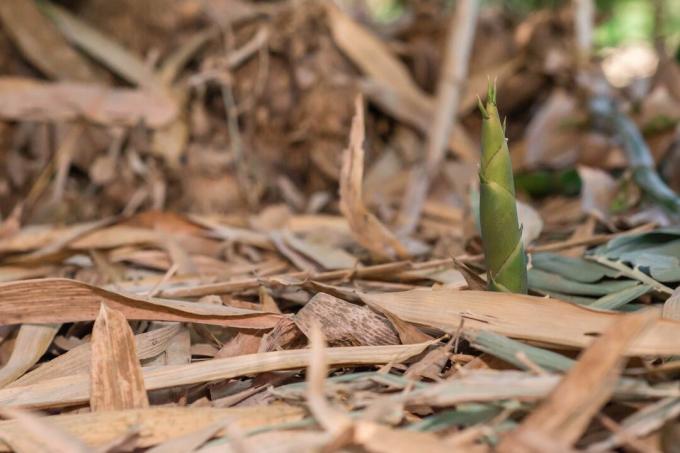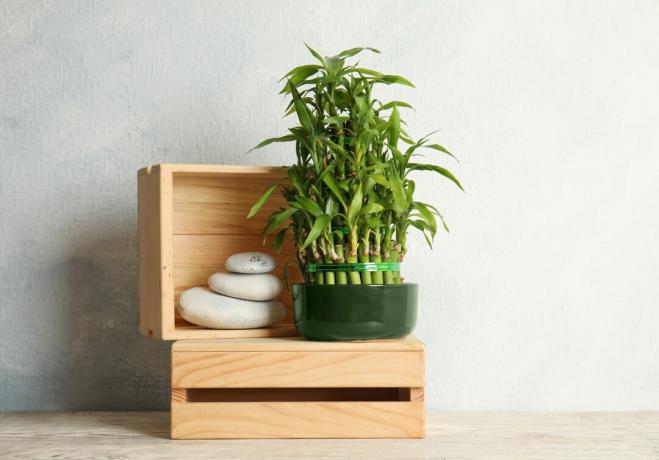The exotic bamboo is now also at home with us. We show when, how and with what to properly fertilize and supply the bamboo with nutrients.

Bamboo (Bambusoideae) is known for its rapid growth. Even without any action, bamboo grows towards the sky like a weed. However, if the Asian sweet grass (Poaceae) is to grow to its full height and lush green beauty, additional nitrogen fertilization is essential. This is because bamboo is one of the heavy consumers and has a special need for the chemical element. The plants need a lot of nutrients and minerals in order to be able to muster enough energy for the enormous sprouting.
In order for your garden to shine in a green sea of leaves even in winter, it is important to provide your bamboo with the optimal amount of nutrients and minerals. In other words, attention must be paid to correct fertilization. But which fertilizer is particularly suitable for bamboo and when and how much should you fertilize?
contents
- Fertilize bamboo: the best time
-
Bamboo fertilizer: How and with what to fertilize?
- Fertilize bamboo organically
- Fertilize bamboo with minerals
- Fertilize bamboo with home remedies
Fertilize bamboo: the best time
The bamboo can be supplied with nutrients for the first time when it is planted. For this purpose, the potting soil is mixed with well-ripened compost. There is also special bamboo soil that is supposed to promote growth through an adapted composition. If you plant your bamboo in special soil, you do not need to fertilize again for the first three months. The nutrients within the substrate, whether compost mixture or special soil, should normally be sufficient and provide the plant with optimal care.
After this time, fertilizer is applied shortly before the stalks sprout – in the case of older plants from mid-April. You should use the fertilizer a total of two to three times at intervals of about four weeks. To ensure that your bamboo gets through the winter as unscathed as possible, fertilize for the last time at the end of August at the latest. This gives the new stalks enough time to mature before frost. When fertilizing with a long-term fertilizer, a single application of fertilizer in the spring is sufficient. This promotes new growth of culms. If you choose an ecological fertilizer in organic quality, you are doing not only your garden a little favor, but all gardens on this planet.

Summary: When is the best time to fertilize bamboo?
- When planting, the potting soil can be mixed with compost or another organic long-term fertilizer
- The first fertilization takes place after 3 months or in the case of existing plants from mid-April
- Fertilize three to four times with an organic fertilizer at intervals of 4 weeks
- The last fertilization takes place at the end of August at the latest
Bamboo fertilizer: How and with what to fertilize?
Bamboo has a good appetite, whereby the focus is particularly on the supply of nitrogen, but also of potassium. A nitrogenous one NPK fertilizer is therefore ideal for caring for your plant. There is also a special fertilizer for bamboo. This supplies the new shoots with a high proportion of nitrogen. The leaf structure is strengthened by silicon and the plant as a whole is more resilient. An additional load of potassium makes your bamboo fit for the winter.
When buying fertilizers, however, you should not only pay attention to the composition of the substances, because there is more to each product than its purpose. When buying, it is best to pay attention to organic fertilizer variants. These contain the nutrients in a form that can be released into the soil at the right dose over a long period of time. This not only saves you constant re-fertilization, but also minimizes the risk of over-fertilization. Because not only too little, but also too much nutrients damage a plant.

Instead of special bamboo fertilizer, you can also use lawn fertilizer such as our Plantura Organic Lawn Fertilizer To fall back on. Because like bamboo, lawn also needs one NPK fertilizer with a high nitrogen content. Our Plantura organic lawn fertilizer offers an optimal supply of primarily organic nutrients without resorting to animal products. In this way you promote soil life in a biological way and reduce the risk of over-fertilization through slow nutrient release.
Tip from the pro: Especially in gardens with low-potassium soil, additional fertilization with autumn lawn fertilizer rich in potassium in August helps the bamboo to become more frost-hardy and robust. Our Plantura Organic autumn lawn fertilizer offers this extra amount of potassium while at the same time being of high quality and animal-free organic quality. The potassium helps with the water supply in winter and allows your bamboo to get through the winter more safely.
Summary: How and with what to fertilize bamboo?
- Use nitrogen-heavy NPK fertilizer; primarily organic fertilizers like our Plantura Organic Lawn Fertilizer offer the advantage of slow nutrient release and vital soil life.
- Special bamboo fertilizer contains silicon for strengthened leaf structure and increased resilience, and potassium to increase frost tolerance.
- Do not remove browning and fallen leaves (more on this in the following section).
- A fertilization with our Plantura Organic autumn lawn fertilizer supports the frost hardiness of your bamboo.
Fertilize bamboo organically
Bamboo needs a lot of strength to grow to its full size. Of course, organic variants also ensure a balanced nutrient ratio in the soil in the right amount. You can use organic liquid fertilizers and granules such as our primarily organic Plantura Organic Lawn Fertilizer fall back on, but also on the following products:
- guano
- Mature manure with high nitrogen content (beef or horse)
- mature compost
- horn shavings/Hornmehl
Silicic acid, or the silicon it contains, is also important for bamboo, as this ensures firm stalks. Therefore, the falling bamboo leaves should not be removed. Conveniently, the leaves contain the required silicon. If not enough foliage has accumulated, or if you prefer to remove unsightly brown leaves right away, you can fertilize with horsetail broth or rock flour such as bentonite or Lucian rock flour. The whole thing is then applied extensively and superficially in the root area.

Tip from the pro: An additional thin layer of bark mulch also stores moisture and thus reduces the watering effort. Even weeds only sparsely get through the mulch layer.
Long-term organic fertilization: instructions and dosage amounts
In order for your garden to resemble an Asian place of tranquility and not an overgrown panda reservoir, it is important to supply the right nutrients in the appropriate amounts. Below we have a step-by-step guide to bamboo happiness with our Plantura Organic Lawn Fertilizer prepared:
- Before planting, work 100 g/m² (0.2 liter jar) of our Plantura organic lawn fertilizer into the top layer of soil
- Water the bottom and freshly inserted bamboo well so that the granulate can be easily loosened
- For maintenance fertilization from mid-April, you should apply 40 - 60 g/m² (min. 10 teaspoons) fertilize
Fertilize bamboo with minerals
If you keep your bamboo in a pot or tub, you can also use a mineral one liquid fertilizer apply in irrigation water. However, you should blue grain and Co. only use carefully and in small doses. However, it is best not to use mineral fertilizers with bamboo because of the high salt content. Use one instead organic fertilizer, in order to save some fertilization or even losses due to over-fertilization and salinization in pot culture. The quick energy boost from mineral fertilizers makes sense if your bamboo gets yellow or brown leaves due to a lack of magnesium, silicon or nitrogen. Here you can also use a mineral fertilizer for quick help. The rapid nutrient release is beneficial in an emergency, but really only then. It is better to act preventively and use long-term fertilizers in spring.

Fertilize bamboo with home remedies
You can also use one to power your bamboo Manure from nettles or put on comfrey. The plant remains are placed in rainwater for two weeks. The slurry is finally ready when it stops bubbling. The whole thing is diluted with water in a ratio of one to ten and the plant is watered with it. Other home remedies such as coffee grounds also provide untold amounts of nitrogen. It is simply distributed in the root area or added to the irrigation water. An all-round supply brings a mix of coffee grounds and horn shavings. This power mixture is superficially worked into the soil in the root area. A layer of grass clippings is then applied. However, coffee grounds have a lowering effect on soil pH, which can lead to acidification. If the soil pH is acidic, however, crushed eggshells can be incorporated into the soil once a year as a remedial measure. These provide lime and thus increase the pH value.
More info about Coffee grounds as fertilizer you'll find here.


